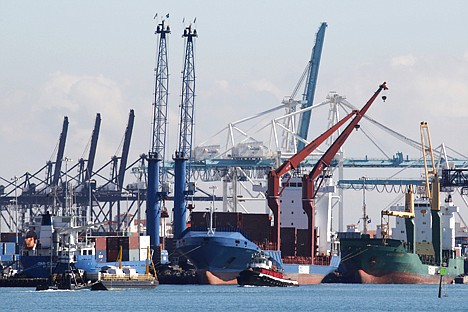Trade deficit narrows to 9-month low in October
WASHINGTON - The U.S. trade deficit fell to its lowest level in nine months, as growing demand for American goods overseas and a falling dollar pushed exports to their highest level in more than two years.
The trade deficit narrowed to $38.7 billion in October, the Commerce Department reported Friday. The figure was 13.2 percent below September's deficit of $44.6 billion.
U.S. exports rose 3.2 percent to $158.7 billion, the highest level since August 2008. Sales of American-made machinery, farm products and autos fueled the growth. Imports dipped 0.5 percent to $197.4 billion, with lower demand for oil and foreign-made cars.
The dollar's value against many major trading partners has been on a downward trend since March 2009. That has helped to boost U.S. exports.
Pierre Ellis, an economist at Decision Economics, said that the jump in exports reflected the decline in the dollar and also stronger economic growth in many U.S. export markets. He said this should help boost overall economic growth in the United States in the current quarter. That would be a switch from previous quarters, when the rising trade deficit had been a drag on U.S. growth.
The big rise in exports should be welcome news for the Obama administration, which has set a goal of doubling American exports as part of the administration's strategy to combat painfully high unemployment in the United States by boosting the fortunes of American manufacturers.
The politically sensitive deficit with China dropped 8.3 percent to $25.5 billion in October, still the largest imbalance with any country. So far this year, the trade gap with China is running 20.3 percent above last year's level and is on track to match the all-time high set in 2008.
That growing deficit has increased political pressure in the United States on Congress and the administration to take a tougher approach on what critics see as China's many unfair trade practices. A key target has been China's policy of keeping its currency significantly undervalued against the dollar which makes Chinese products cheaper for American consumers while increasing the price of U.S. goods in China.
So far this year, the U.S. trade deficit is running at an annual rate of $504.8 billion, up 34.6 percent from the 2009 imbalance of $374.9 billion.
Economists had forecast that the deficit would rise as the U.S. economy recovered but the hope is that strong global demand will boost sales of exports and offset some of the increase in imports. The hope is that a decline in the dollar against many other currencies will help boost the competitiveness of U.S. exports.
The October increase in exports reflected a $374 million rise in sales of capital goods led by increases in exports of industrial engines, drilling equipment, computers and telecommunications equipment. Exports of U.S.-made autos and auto parts rose by $430 million.
The small decline in imports reflected a 6.7 percent fall in imports of petroleum, which fell $25.7 billion, the lowest level in 11 months. Imports of autos and various types of machinery also declined in October.
The U.S. deficit with Canada, America's biggest trading partner, jumped 19.6 percent to $1.1 billion while the deficit with the European Union was up 17.4 percent to $7.1 billion.

